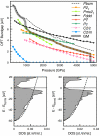High pressure ices
- PMID: 22207625
- PMCID: PMC3271906
- DOI: 10.1073/pnas.1118694109
High pressure ices
Abstract
H(2)O will be more resistant to metallization than previously thought. From computational evolutionary structure searches, we find a sequence of new stable and meta-stable structures for the ground state of ice in the 1-5 TPa (10 to 50 Mbar) regime, in the static approximation. The previously proposed Pbcm structure is superseded by a Pmc2(1) phase at p = 930 GPa, followed by a predicted transition to a P2(1) crystal structure at p = 1.3 TPa. This phase, featuring higher coordination at O and H, is stable over a wide pressure range, reaching 4.8 TPa. We analyze carefully the geometrical changes in the calculated structures, especially the buckling at the H in O-H-O motifs. All structures are insulating--chemistry burns a deep and (with pressure increase) lasting hole in the density of states near the highest occupied electronic levels of what might be component metallic lattices. Metallization of ice in our calculations occurs only near 4.8 TPa, where the metallic C2/m phase becomes most stable. In this regime, zero-point energies much larger than typical enthalpy differences suggest possible melting of the H sublattice, or even the entire crystal.
Conflict of interest statement
The authors declare no conflict of interest.
Figures


 ), Pbcm, and Pmc21, seen along the a axis. Unit cells are indicated (
), Pbcm, and Pmc21, seen along the a axis. Unit cells are indicated ( cell for ice X). All structures are at p = 700 GPa (and ground-states).
cell for ice X). All structures are at p = 700 GPa (and ground-states).

 structure. Left: along the c axis; middle: the two sublattices, along the a axis; right: one of the two interpenetrating networks.
structure. Left: along the c axis; middle: the two sublattices, along the a axis; right: one of the two interpenetrating networks.



References
-
- Petrenko VF, Whitworth RW. Physics of Ice. Oxford: Oxford University Press; 1999.
-
- Salzmann CG, Radaelli PG, Mayer E, Finney JL. Ice XV: A New Thermodynamically Stable Phase of Ice. Phys Rev Lett. 2009;103:105701. - PubMed
-
- Ross M. The ice layer in Uranus and Neptune—diamonds in the sky? Nature. 1981;292:435–436.
-
- Podolak M, Weizman A, Marley M. Comparative models of Uranus and Neptune. Planet Space Sci. 1995;43:1517–1522.
-
- Beaulieu J-P, et al. Discovery of a cool planet of 5.5 Earth masses through gravitational microlensing. Nature. 2006;439:437–440. - PubMed
Publication types
MeSH terms
Substances
LinkOut - more resources
Full Text Sources

